Index

Review: Dual Graphics can make a big difference
Today we'll take a closer look at AMD's A8-7600 APU Kaveri APU, more specifically we'll examine the GPU performance you can expect from this frugal APU. AMD still enjoys a comfortable lead over Intel in terms of integrated graphics performance and as an added bonus AMD APUs support Dual Graphics, allowing users to boost performance by adding a low-end discrete Radeon to their system. Some games support Mantle and the user can see considerable performance boost in such games. We will provide a comparison between the new drivers and the drivers which were available when the A8-7600 APU was released back in January. Also our tests support AMD’s official line – speedy memory makes a big difference.
In case you haven’t been following developments on the iGPU front, you could be in for a nice surprise, as integrated GPUs have come a long way over the past couple of years.
At the beginning we will give a basic info for the users not familiar with the Kaveri APU architecture. The company announced the 65W A8-7600 chip months ago, but it is still not available. The more powerful A10-7850 and A10-7700K, both 95W parts, have been on sale for months. They are currently the only Kaveri desktop APUs available in retail. The second batch of AMD Kaveri APUs, announced last week, includes the A4-7300, the A6-7400K and the A10-7800. A new A6-7400 is up for pre-order in the US, but it is still not available. The A6-7600 is a dual-core chip. It has 1MB of L2 cache, unlocked multiplier, 65W TDP and it is clocked at 3.5GHz, or 3.9GHz on Turbo. The chip packs Radeon R5 graphics clocked at 726MHz.
The A8-7600 can operate as a 45W part, but you can also set it to 65W simply by changing a few BIOS settings. This is a new feature and we must admit we like it. In 45W mode the A8-7600 operates at 3.1GHz base and 3.3GHz Boost clocks, but once you bump it up to 65W it runs at 3.3GHz/3.8GHz. The A8-7600 is of course an FM2+ part.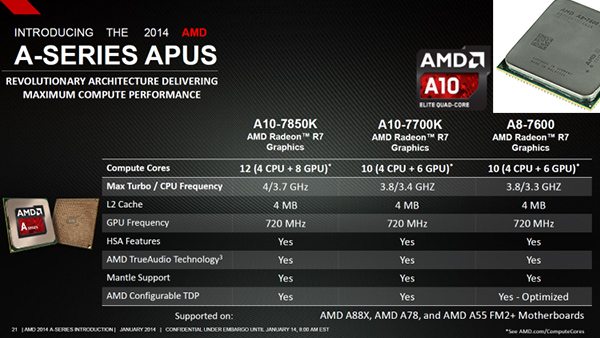
The A8-7600 features Radeon R7 graphics with 384 GCN shaders and in 3D mode it runs at 720MHz. It is worth noting that the GPU clock is the same whether you use the chip in 45W or 65W mode. Kaveri officially supports 2133MHz DDR3 memory and memory speed plays a big role in GPU performance, since it is shared by the CPU and GPU cores.
We ran our tests on a system supplied by AMD, which came in the form of a lovely black cube, courtesy of Xigmatek. However, don’t let looks fool you. The small Xigmatek Nebula cube contains quite a few quality components, which you might not expect in small_PC rig, so let’s take a look at the building blocks of AMD’s sample.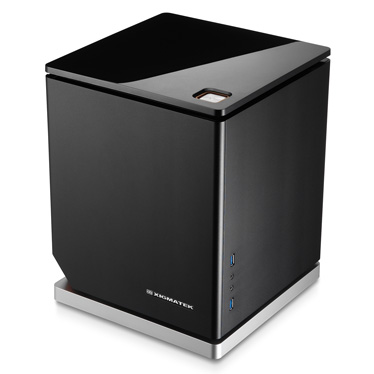
The A8-7600 APU sits atop a Asrock FM2A88X-ITX+ motherboard. The FM2A88X-ITX+ board is feature packed, with two USB 3.0 ports and two USB 3.0 headers, two PC-19200U DDR3 memory slots, WiFi and Bluetooth 4.0, HDMI 1.4 and 802.11a/b/g/n/ac WiFi. That’s pretty impressive for a mini-ITX board.
AMD decided to use 16GB of Radeon DDR3 memory (2133MHz), a Samsung 840 Pro 256GB SSD, Antec High Current Pro 750W PSU and last but not least, a low profile Noctua CPU cooler. The chassis can accommodate a much bigger cooler though.
Right off the bat we have to point out that some of the components are overkill. You won’t find many mid-range systems with 16GB of 2133MHz memory, a speedy 256GB SSD or a quality 750W PSU. However, if you’re planning to build a Kaveri rig on a tight budget, don’t worry. We ran a few tests with just 8GB of memory, which proved more than enough in most situations. There’s a huge choice of cheap 120-128GB SSDs, too, not to mention cheaper, less powerful PSUs.
You can cut quite a few corners and save a lot of cash without compromising performance, which is good news considering AMD’s decision to position the A8-7600 opposite Intel’s Core i3-4330 (Haswell). The tradeoff will be worth it for most users, as the performance penalty will be negligible.
We included a number of benchmark figures with 8GB of RAM and we also tried to play around with the GPU, allocating 1GB and 2GB of RAM for the frame buffer. BIOS automatically allocates 1GB of memory to the on-die Radeon R7, which is sufficient. However, in case you really need 2GB, you can allocate it, although most users shouldn’t bother.
We compared the performance of the 14.6 driver with the driver supplied to us during initial review back in January. In the graphs the newer driver is explicitely denoted after the APU designation.
Mantle tests yielded mixed results. Mantle delivers the best results in CPU-bound games, on configurations with powerful GPUs and somewhat slower CPUs. It benefits the CPU rather than the GPU, as it eliminates a lot of CPU overhead. An integrated GPU backed by an entry-level discrete card doesn’t really fit the bill, but Mantle still provided us with an 18-percent performance boost in Battlefield 4. It might not sound like much, but it makes a visible difference.
First we want to show you our results without Mantle. The 14.6 beta driver provided us with a 3% gain in DirectX 11 rendering compared to the first beta driver from January. The on-die GPU can deliver playable framerates in Battlefield 4, but you have to lower in-game graphics details to minimum or medium.

As you can see from the following graph, with the A8-7600 and its on-die R7 GPU we got a 15-percent performance uplift thanks to Mantle. This resulted in near smooth gaming at 1080p at medium details, which is very impressive for a mid-range processor with integrated graphics.
The next results also prove that there is no significant difference between using 1GB or 2GB of RAM for the GPU. Whether the system has 8GB or 16GB of system RAM also makes no difference, but speed matters, and we show that in the next page.
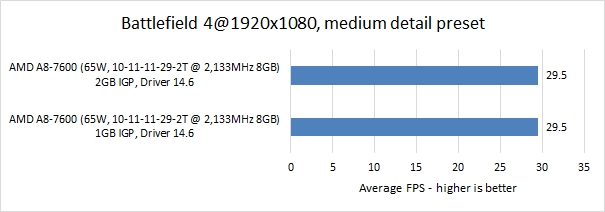
GPU performance is greatly affected by the system memory speed. In Battlefield 4 we can see a lot of scaling caused by memory speed and the next graph illustrates this (Mantle was not enabled). Overclocking the memory from 1333MHz to 2133MHz improved our gaming scores by up to 30 percent.
The AMD sample system was equipped with 16GB of RAM, but frankly 8GB is enough for a system based on this particular APU. You can allocate up to 2GB for the GPU, but there’s really no need to. We carried out a few tests with 2GB of memory set aside for the GPU and the results proved that 1GB is enough for the on-die R7 GPU.
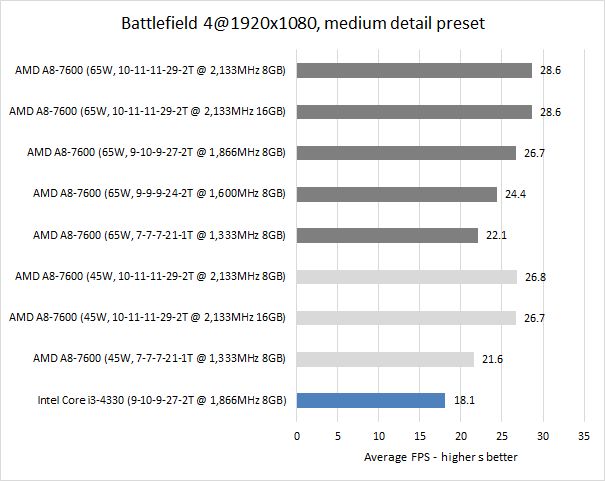
Like we said, memory speed has a huge impact on the performance of the A8-7600, namely on its on-die GPU with 384 GCN shaders. Aida tests reveal that memory read bandwidth and memory latency improve when faster memory modules are installed, but more importantly real life performance in games reflects this fact.
Here is some info about Aida 64 memory tests. Memory bandwidth benchmarks (Memory Read, Memory Write, Memory Copy) measure the maximum achievable memory data transfer bandwidth. The code behind these benchmark methods are written in Assembly and they are extremely optimized for every popular AMD, Intel and VIA processor core variants by utilizing the appropriate x86/x64, x87, MMX, MMX+, 3DNow!, SSE, SSE2, SSE4.1, AVX, and AVX2 instruction set extension. The Memory Latency benchmark measures the typical delay when the CPU reads data from system memory. Memory latency time means the time ‘penalty’ measured from issuing the read command until the data arrives to the integer registers of the CPU.

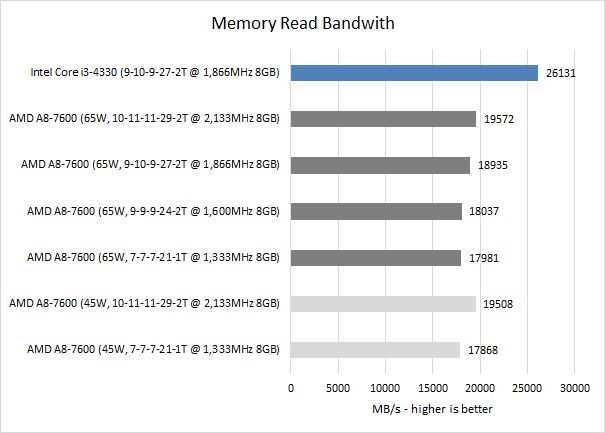

BioShock Infinite on the medium detail preset at 1080p is not really playable, but 25 FPS is not bad, either. The 14.6 beta driver delivers 2% performance improvement over the first beta driver.

Crysis 3 overpowers the integrated GPU even at low detail settings at 1080p. Older driver which was given to us in January for the first review provides better result in Crysis 3 game, but not in other games we tested today.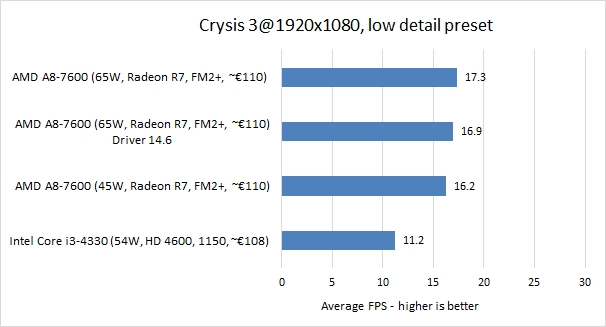

The R7 GPU can’t deliver smooth gameplay in Hitman Absolution at 1080p medium in-game settings. Here we also see 2% better performance thanks to the newer beta driver.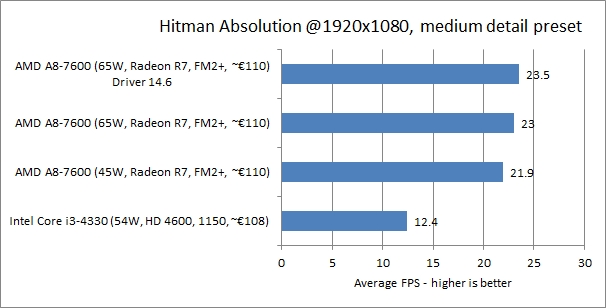
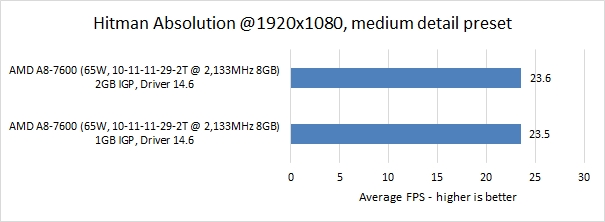
For an integrated GPU, 28 FPS is not bad.

There are a few things to keep in mind when dealing with Dual Graphics. The only discrete cards supported by Kaveri APUs in Dual Graphics mode are the R7 240 and R7 250. The R7 250X is not supported and neither is the R5 230. AMD suggests DDR3 cards, which is good news as they tend to be somewhat cheaper than GDDR5 cards.
For the Crossfire test we paired the on-die R7 with the XFX R7 240 Core Editon graphics card. If you care, the exact designation of the discrete card we used in the test is the XFX Core Radeon R7 240 780MHz BOOST READY 2GB DDR3 LOW PROFILE PASSIVE HDMI DVI VGA, and the product code is R7-240A-CLH4.
The performance gains are substantial and as our results prove even the cheap Dual Graphics rig (R7 iGPU + R7 240) will make quite a few titles playable at 1080p. In essence, adding a $70/€50 card can make a big difference. To make it all work, you need to activate AMD Radeon Dual Graphics in the Catalyst Control Center.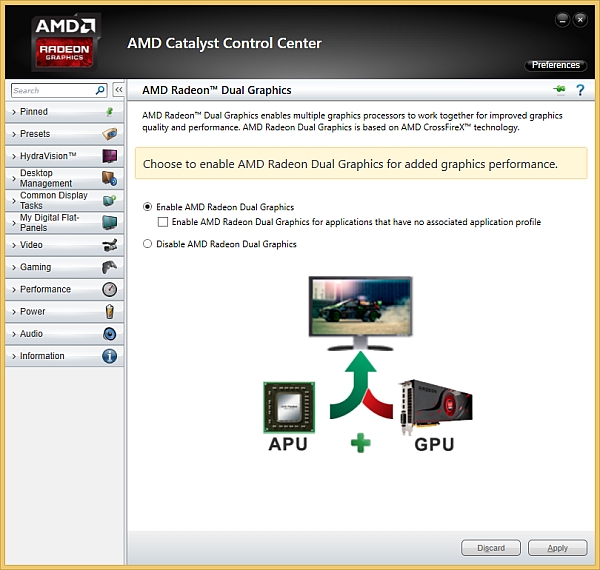
In case that Catalyst Control Center does not offer a Dual Graphics option, you will have to head into BIOS to activate this option. Bear in mind that this was the case with our Asrock FM2A88X-ITX+ motherboard, the method of activating Dual Graphics varies from board to board. For example, to make Dual Graphics work, we needed to explicitly instruct the system to use Dual Graphics. The Auto option was on by default, but Crossfire support was not available until we switched to the Dual Graphics/Surround View option. On some motherboards this option is called IGFX Multi-Monitor.
If these BIOS tweaks do not help, try setting the Primary Video Device/Primary Graphics Adapter to PCI Express, while at the same time enabling onboard graphics. It is not a lot of work, but novice users might not like having to deal with BIOS settings even if this is relatively basic stuff.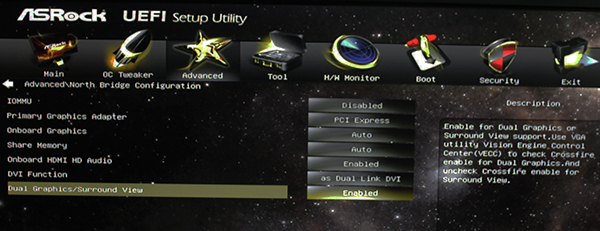
In OverDrive we can configure the GPU core clock and memory clock of the discrete graphics card, but not the on-die GPU core clock which is fixed.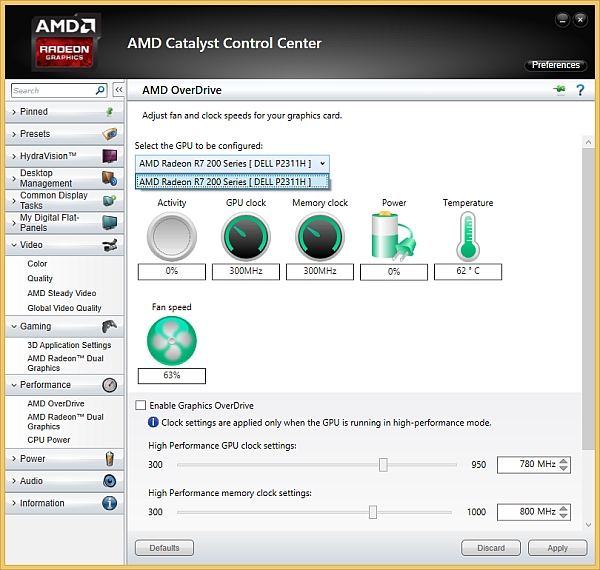
GPUz detected both GPUs. As you can see, we decided to carry out the tests with 1GB and 2GB of RAM allocated for the integrated GPU. We already proved that allocating more memory for the on-die R7 GPU does not make a difference and the same is true of Crossfire tests. We decided to try it out with 2GB because the discrete R7 240 features 2GB of memory.
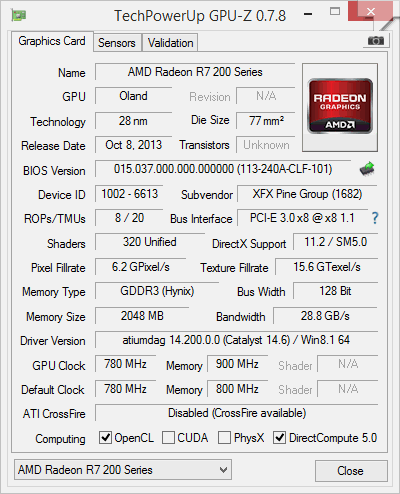
While testing the integrated R7 GPU, we used system memory clocked at 2133MHz. The use of fast DDR3 system memory allows the integrated GPU to shine through, as it benefits from more bandwidth (34.1GB/s vs. 28.8GB/s on the R7 240). Note that the difference in performance between the two GPUs also stems from the fact that the integrated R7 features 384 stream processors, while the discrete R7 240 (Oland Pro core) has 320 stream processors.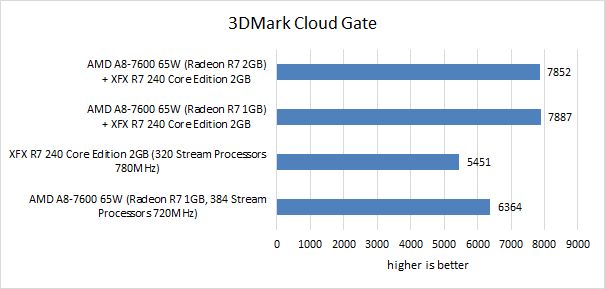
Crossfire with R7 240 delivers a 40% boost in 3DMark Fire Strike.
Tomb Raider also saw a substantial performance gain.
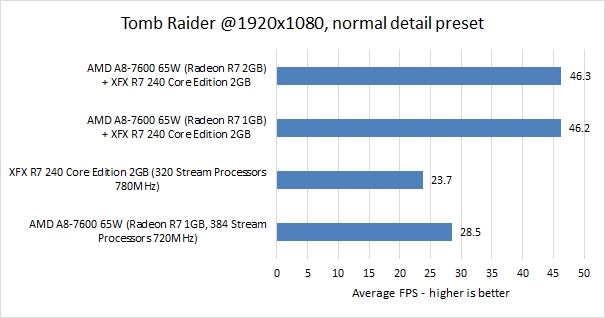
Hitman in Dual Graphics mode yields a 37% performance gain.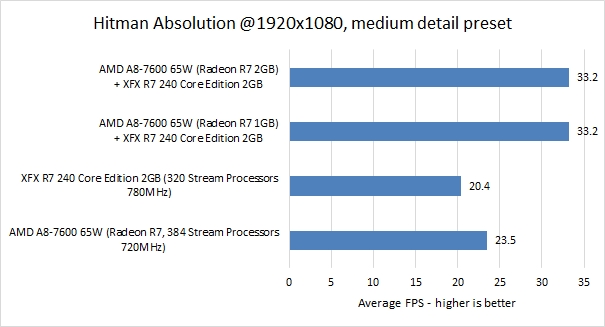
In Crysis we got a 48% performance gain with the R7 240 in tow.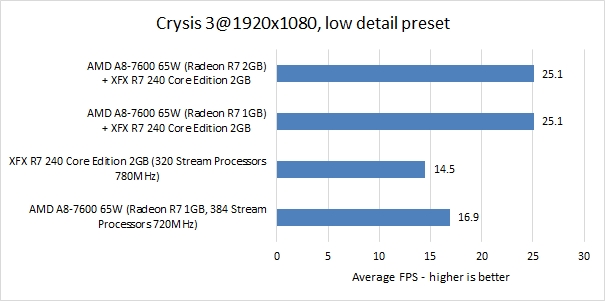
Bioshock fares even better, with a 66% gain.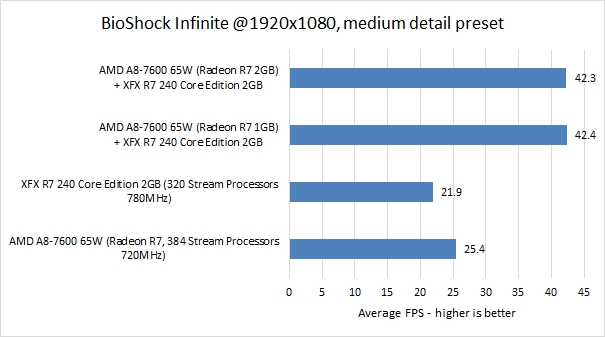
In Battlefield 4, on medium settings and 1080p, we got a great score, with a very playable 49fps. Mantle and Dual Graphics did not deliver a huge improvement, but performance was nonetheless impressive. Mantle boosted performance by about 15 percent. We expect AMD’s support for Mantle to improve with every software update, so this might not be the end of the story.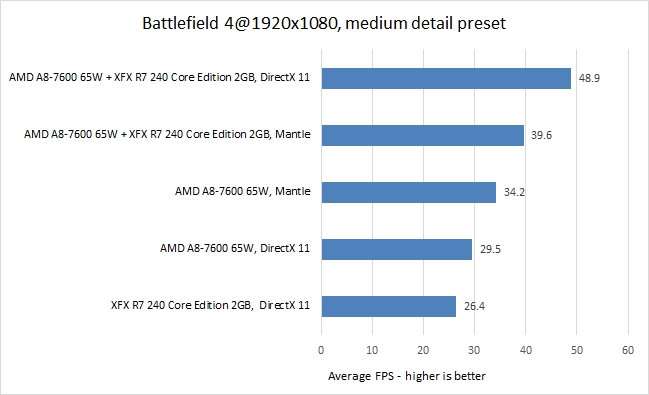
The Kaveri A8-7600 with Radeon R7 on-die graphics is supposed to offer an attractive all-in-one solution for mainstream users. At $119 it is relatively affordable and it makes a lot of sense for casual gamers or home users. Sadly though, the A8-7600 is still not available in retail, although it was announced a couple of months ago.
The A10-7700K and A10-7850K are the only Kaveri desktop parts you can actually buy today. They are quite a bit more expensive and both are 95W parts. Last week AMD announced the A6-7600, 65W dual core APU, priced at $86 making it about $30 cheaper than the quad core A8-7600. Also new is the A10-7800, a 65W quad core APU which should have a retail/e-tail price of around US $150.
The A8-7600 on-die GPU is vastly superior to Intel’s offerings in this price range, but as usual Intel pulls ahead in the CPU department. However, in many respects the A8-7600 looks like a more balanced package, as it delivers a lot more GPU performance in market segment dominated by integrated graphics.
At lower resolutions and with lower detail settings, the A8-7600 can run some nice games, not to mention older titles or certain undemanding genres. So, while it’s not fast enough to meet the demands of regular gamers, the A8-7600 delivers quite a punch. In some instances the integrated Radeon R7 even manages to beat low-end discrete cards. What’s more, you can boost performance by adding an entry-level Radeon discrete card to the mix.
With an R7 240 on board, our Kaveri cube was transformed into a small gaming rig capable of running the latest games at 1080p, with low to medium details. High details and gratuitous eye candy should not be a problem in somewhat older titles. Needless to say this is very impressive for a $119 processor backed by a $69 graphics card.
The speed of the system memory plays a huge role because the on-die GPU uses system memory. We've carried out a few tests and they proved that making a small investment in faster RAM pays off if you are planning to buy a Kaveri-based system.
And then there's Mantle. The Mantle uplift varies greatly depending on the configuration and the biggest benefits are to be reaped on the CPU side of things, when the system is not bottlenecked by a weak GPU. However, even with an A8-7600 APU and on-die GPU we saw a good 15% better results with Mantle in Battlefield 4. There is a caveat though. We still don’t know how much traction Mantle will get moving forward and due to some teething problems it does not really work with Dual Graphics. We expect AMD to iron out the issues sooner or later.
Bottom line, AMD did a pretty good job with Kaveri. Intel still has a clear lead in terms of CPU performance, but the value proposition easily swings to AMD’s side if you want a more balanced system sans discrete graphics. The A8-7600 is interesting on more than one level. Unlike the three A10-series Kaveri parts, the frugal A8-7600 can operate at just 45W, it is relatively affordable and in case you ever need more GPU performance on a budget you can always get a cheap R7 240 for some Dual Graphics action.
In short, although the latest, graphically demanding titles are not playable at 1080p, bear in mind that we are talking about a $119 APU with no discrete graphics. When we factor in the price and the fact that this is merely a mid-range processor, we must admit we are very impressed by the level of performance offered by the on-die Radeon R7.
We would gladly recommend the A8-7600, but it's simply not available and we have no idea when AMD plans to actually ship it.
